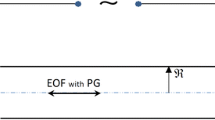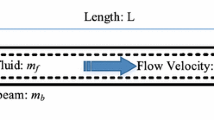Abstract
The transition to turbulent flow is studied for liquids of different polarities in glass microtubes having diameters between 50 and 247 µm. The onset of transition occurs at Reynolds numbers of ~1,800–2,000, as indicated by greater-than-laminar pressure drop and micro-PIV measurements of mean velocity and rms velocity fluctuations at the centerline. Transition at anomalously low values of Reynolds number was never observed. Additionally, the results of more than 1,500 measurements of pressure drop versus flow rate confirm the macroscopic Poiseuille flow result for laminar flow resistance to within −1% systematic and ±2.5% rms random error for Reynolds numbers less than 1,800.






Similar content being viewed by others
References
Baggett J, Trefethen L (1997) Low-dimensional models of subcritical transition to turbulence. Phys Fluids 9:1043–1053
Choi SB, Barron RF, Warrington RO (1991) Fluid flow and heat transfer in microtubes. In: Micromechanical sensors, actuators, and systems. ASME, New York, pp 123–134
Christensen KT, Soloff S, Adrian RJ (2000) PIV Sleuth: integrated particle image velocimetry interrogation/validation software. TAM Report No. 943, Department of Theoretical and Applied Mechanics, University of Illinois at Urbana-Champaign
Darbyshire AG, Mullin T (1995) Transition to turbulence in constant-mass-flux pipe flow. J Fluid Mech 289:83–114
Draad AA, Kuiken GDC, Nieuwstadt FTM (1998) Laminar-turbulent transition in pipe flow for Newtonian and non-Newtonian fluids. J Fluid Mech 377:267–312
Flockhart SM, Dhariwal RS (1998) Experimental and numerical investigation into the flow characteristics of channels etched in 〈100〉 silicon. J Fluids Eng 120:291–295
Gad-el-Hak M (1999) The fluid mechanics of microdevices—The Freeman Scholar Lecture. J Fluids Eng 121:5–33
Goldstein RJ, Adrian RJ, Kried DK (1969) Turbulent and transition pipe flow of dilute aqueous polymer solutions. IEC Fundamentals 8:498–502
Jiang XN, Zhou ZY, Li Y, Ye XY (1995) Micro-fluid flow in microchannel. In: Eighth International Conference on Solid-state sensors and actuators, and Eurosensors IX, Stockholm, Sweden. IEEE, Piscataway, NJ, pp 317–320
Judy J, Maynes D, Webb B (2002) Characterization of frictional pressure drop for liquid flows through microchannels. Int J Heat Mass Transfer 45:3477–3489
Lundbladh A, Henningson D, Reddy S (1994) Threshold amplitudes for transition in channel flows. In: Hussaini M, Gatski B, Jackson T (eds) Transition, turbulence and combustion, vol 1. Kluwer, Dordrecht, pp 309–318
Mala GM, Li D (1999) Flow characteristics of water in microtubes. Int J Heat Fluid Flow 20:142–148
Obot N (2002) Toward a better understanding of friction and heat/mass transfer in microchannels—a literature review. Microscale Thermophys Eng 6:155–173
Olsen MG, Adrian RJ (2000) Out-of-focus effects an particle image visibility and correlation in microscopic PIV. Exp Fluids 29:5166–5174
O’Sullivan P, Breuer K (1994) Transient growth in circular pipe flow. II. Nonlinear development. Phys Fluids 6:3652–3664
Papautsky I, Brazzle J, Ameel T, Frazier AB (1999) Laminar fluid behavior in microchannels using micropolar fluid theory. Sensors Actuators 73:101–108
Parry W, Bellows J, Gallagher J, Harvey A (2000) ASME international steam tables for industrial use. ASME, New York
Patel VC, Head MR (1969) Some observations on skin friction and velocity profiles in fully developed pipe and channel flows. J Fluid Mech 38:181–201
Peng X, Peterson G, Wang B (1994a) Heat transfer characteristics of water flowing through microchannels. Exp Heat Transfer 7:265–283
Peng XF, Peterson GP, Wang BX (1994b) Frictional flow characteristics of water flowing through rectangular microchannels. Exp Heat Transfer 7:249–264
Pfahler J, Harley J, Bau H, Zemel J (1990) Liquid transport in micron and submicron channels. Sensors Actuators A21–A23:431–434
Pfahler J, Harley J, Bau H, Zemel J (1991) Gas and liquid flow in small channels. In: Cho D, Warrington Jr, R, Pisano A, Bau H, Friedrich X, Jara-Almonte J, Liburdy J (eds) Dynamic Systems and Control, vol 32, Micromechanical sensors, actuators and systems. ASME, New York, pp 49–60
Pfund D, Rector D, Shekarriz A, Popescu A, Welty J (2000) Pressure drop measurements in a microchannel. AIChE J 46:1496–1507
Qu W, Mala GM, Li D (2000) Pressure-driven water flows in trapezoidal silicon microchannels. Int J Heat Mass Transfer 43:353–364
Sharp K (2001) Experimental investigation of liquid and particle-laden flows in microtubes. PhD thesis, University of Illinois at Urbana-Champaign
Sharp K, Adrian R, Santiago J, Molho JI (2001) Liquid flows in mirochannels. In: CRC handbook of MEMS. CRC Press, Boca Raton, FL, pp 6.1–6.38
Sobhan C, Garimella SV (2001) A comparative analysis of studies on heat transfer and fluid flow in microchannels. Microscale Thermophys Eng 5:293–311
Travis K, Todd B, Evans D (1997) Departure from Navier–Stokes hydrodynamics in confined liquids. Phys Rev E 55(4): 4288–4295
Trefethen L, Trefethen A, Reddy S, Driscoll T (1993) Hydrodynamic stability without eigenvalues. Science 261(5121):578–584
Trethway D, Meinhart C (2002) Apparent fluid slip at hydrophobic microchannel walls. Phys Fluids 14:L9–L12
Tumin A (1999) Onset of turbulence in circular pipe flows. In: Fasel H, Saric W (eds) Laminar–turbulent transition. IUTAM Symposium, Sedona, AZ. Springer, New York Berlin Heidelberg, pp 377–382
White FM (1994) Fluid mechanics. McGraw-Hill, New York
Wilding P, Pfahler J, Bau HH, Zemel JN, Kricka LJ (1994) Manipulation and flow of biological fluids in straight channels micromachined in silicon. Clin Chem 40:43–47
Wu P, Little WA (1983) Measurements of friction factor for the flow of gases in very fine channels used for micro miniature Joule–Thompson refrigerators. Cryogenics 23:273–277
Wygnanski IJ, Champagne FH (1973) On transition in a pipe. Part 1. The origin of puffs and slugs and the flow in a turbulent slug. J Fluid Mech 59:281–335
Yu D, Warrington R, Barron R, Ameel T (1995) An experimental and theoretical investigation of fluid flow and heat transfer in microtubes. In: ASME/JSME Thermal Engineering Conference, Lahaina, Maui, Hawaii, vol 1. ASME, New York, pp 523–530
Acknowledgements
This work was supported by the Defense Advanced Research Projects Agency, Microsystems Technology Office, Microflumes and Composite Computer-Aided-Design Programs, Grant # F33615-98-1-2853.
Author information
Authors and Affiliations
Corresponding author
Additional information
An erratum to this article can be found at http:dx.doi.org/10.1007/s00348-004-0893-0
Rights and permissions
About this article
Cite this article
Sharp, K.V., Adrian, R.J. Transition from laminar to turbulent flow in liquid filled microtubes. Exp Fluids 36, 741–747 (2004). https://doi.org/10.1007/s00348-003-0753-3
Received:
Accepted:
Published:
Issue Date:
DOI: https://doi.org/10.1007/s00348-003-0753-3




